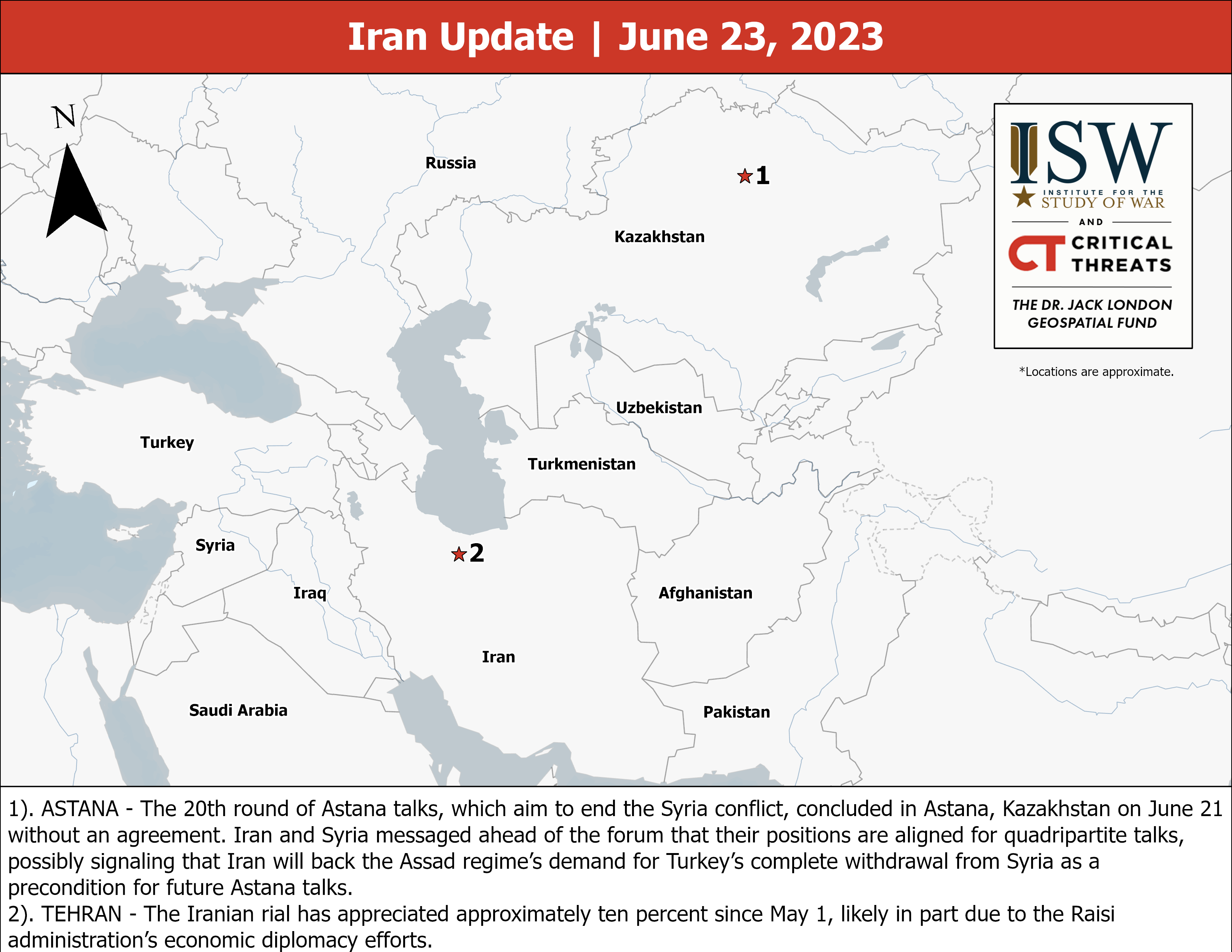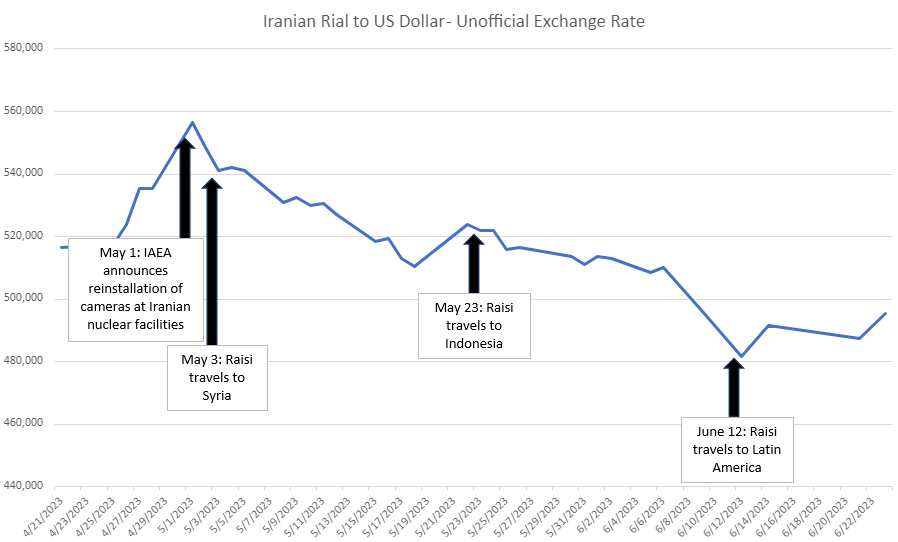The Iran Update aims to inform national security policy by providing timely, relevant, and independent open-source analysis of developments pertaining to Iran and its Axis of Resistance. This update covers political, military, and economic events and trends that affect the stability and decision-making of the Iranian regime. It also provides insights into Iranian and Iranian-sponsored activities abroad that undermine regional stability and threaten US forces and interests. The Critical Threats Project (CTP) at the American Enterprise Institute with support from the Institute for the Study of War (ISW) provides these updates Monday through Friday. To receive Iran Updates via email, please subscribe here.
The Institute for the Study of War (ISW) with support from the Critical Threats Project (CTP) at the American Enterprise Institute launched a new interactive map of Iran and the Middle East. The map depicts events in Iran that affect the stability of the Iranian regime, namely anti-regime protests and reported poisoning incidents. It also shows developments in Syria that jeopardize regional stability and pose threats to US forces and interests, including Iranian and Iranian-backed militia positions.
Key Takeaways
- The 20th round of Astana talks, which aim to end the Syria conflict, concluded in Astana, Kazakhstan on June 21 without an agreement. Iran and Syria messaged ahead of the forum that their positions are aligned for quadripartite talks, possibly signaling that Iran will back the Assad regime’s demand for Turkey’s complete withdrawal from Syria as a precondition for future Astana talks.
- The Iranian rial has appreciated approximately ten percent since May 1, likely in part due to the Raisi administration’s economic diplomacy efforts. The Raisi administration’s economic diplomacy combined with ongoing nuclear talks may have generated confidence in the future of the Iranian economy, consequently increasing the value of the rial.

Iranian Activities in the Levant
This section covers Iranian efforts to consolidate and expand Tehran’s economic, military, and political influence throughout the Levant and especially in Syria. This section examines some of the many campaigns that Iran is pursuing to achieve this strategic objective. CTP will update and refine our assessments of these campaigns over time and in future updates.
The 20th round of Astana talks, which aim to end the Syria conflict, concluded in Astana, Kazakhstan on June 21 without an agreement. Iran and Syria messaged ahead of the forum that their positions are aligned for quadripartite talks, possibly signaling that Iran will back the Assad regime’s demand for Turkey’s complete withdrawal from Syria as a precondition for future Astana talks.[i] Iran, Russia, and Turkey— the guarantors of the Astana Process—met for the 20th Astana talk since 2017 and issued nearly identical final statements as the last year’s forum, which indicates the Astana negotiations remain stalled.[ii] Syrian Deputy Foreign Minister Ayman Soussan described total Turkish withdrawal from Syrian territory as the only possible starting point for cooperation and identified Turkish support for Hayat Tahrir as-Sham, an Islamist Syrian opposition group based in Idlib, as unacceptable.[iii] The deputy foreign ministers of Iran, Russia, Syria, and Turkey held several separate bilateral and quadripartite meetings on the sidelines of the Astana Process to discuss normalizing relations between Turkey and Syria.[iv] The four parties largely agree on the issues of counterterrorism, returning refugees, expelling the United States from Syria, but not the four areas Turkey occupies in northern Syria.
Iranian Domestic and Political Affairs
This section covers factors and trends affecting regime decision-making and stability. CTP will cover domestic politics, significant protest activity, and related issues here.
The Iranian rial has appreciated approximately ten percent since May 1, likely in part due to the Raisi administration’s economic diplomacy efforts.[v] The value of the rial dropped from around 450,000 to 584,000 against the US dollar in February and fluctuated between 500,000 to 557,000 until early May. The appreciation of the rial began just before President Ebrahim Raisi’s widely publicized May 3 trip to Syria, during which high-ranking Iranian and Syrian officials signed 15 economic cooperation agreements.[vi] Raisi also traveled to Indonesia on May 23 to boost economic ties with this country.[vii] High-ranking Raisi administration and Indonesian officials separately signed 11 energy, pharmaceutical, petrochemical, and technology cooperation agreements in Jakarta.[viii] Indonesia’s location between the Indian and Pacific Oceans makes it an advantageous partner for Iran to transport oil to China, the main destination of Iranian oil exports, as CTP previously reported.[ix] Foreign Affairs Minister Hossein Amir Abdollahian additionally engaged in economic diplomacy with several regional and extraregional countries within this timeframe, including Kuwait, Nicaragua, Oman, Qatar, Russia, Saudi Arabia, Syria, the UAE, and Venezuela. The Raisi administration implemented some domestic policies as early as February to offset the devaluation of the rial, but CTP cannot link these policies to the appreciation of the currency to those policies.
The appreciation additionally correlates with developments in Iran’s nuclear negotiations with the West. The International Atomic Energy Organization announced on May 1—right before the rial began to appreciate--that it began reinstalling cameras in several Iranian nuclear facilities.[x] Numerous Iranian officials, including Supreme Leader Ali Khamenei, have expressed support for a nuclear agreement in recent weeks, further indicating that nuclear negotiations are progressing.[xi] The Raisi administration’s economic diplomacy combined with ongoing nuclear talks may have generated confidence in the future of the Iranian economy, consequently increasing the value of the rial.

Source: Bonbast.com
Iran is attempting to unify Palestinian resistance groups following recent Israeli strikes against Palestinian Islamic Jihad in Gaza. including Supreme Leader Ali Khamenei--met with Hamas and Palestinian Islamic Jihad (PIJ) political leadership in Tehran between June 14 and 22, indicating the regime’s increased focus on Palestinian resistance efforts in recent weeks.[xii] Khamenei and Raisi emphasized the need for a unified front between Palestinian groups during their meetings with Hamas Political Bureau Chief Esmail Haniyeh and PIJ Secretary General Ziyad Nakhalah on June 19, 20, and 21. Khamenei separately claimed that Israel was attempting to create “divisions and differences” among Palestinian resistance groups. Khamenei’s comments follow reports of divisions between Palestinian groups following Israeli decapitation strikes against PIJ leadership on May 9.[xiii]
Iranian efforts to unify Palestinian resistance groups coincides with recent regime interest in expanding resistance operations in the West Bank. Khamenei emphasized the need to strengthen West Bank resistance groups during his meeting with Nakhala on June 14 and Haniyeh on June 21. Raisi and Ahmadian echoed Khamenei’s call for expanding operations in the West Bank in separate meetings with Nakhala and Haniyeh on June 17 and 19. IRGC Commander Major General Hossein Salami previously endorsed arming resistance groups in the West Bank to target Israel from multiple directions in an interview with the Supreme Leader’s website in August 2022, as CTP previously reported.[xiv]
Anti-regime protests in Sistan and Baluchistan Province increased significantly on June 23, demonstrating that residents remain undeterred from further protest despite the brutal regime crackdown during the Mahsa Amini movement. Residents in at least six cities in Sistan and Baluchistan Province engaged in anti-regime protests after Friday prayers on June 23.[xv] Reports of an assassination attempt on prominent Sunni Cleric Moulana Abdol Hamid on June 19 may have resulted in increased protest activity within this province on June 23.[xvi]
[i] https://sana[dot]sy/?p=1918441
[ii] https://sana[dot]sy/?p=1919436
[iii] https://sana[dot]sy/?p=1919264
[iv] https://mfa[dot]ir/portal/NewsView/722585 ; https://www.irna[dot]ir/news/85146331/%D8%AF%DB%8C%D8%AF%D8%A7%D8%B1-%D8%AE%D8%A7%D8%AC%DB%8C-%D8%A8%D8%A7-%D9%85%D8%B9%D8%A7%D9%88%D9%86%D8%A7%D9%86-%D9%88%D8%B2%DB%8C%D8%B1%D8%A7%D9%86-%D8%AE%D8%A7%D8%B1%D8%AC%D9%87-%D8%AA%D8%B1%DA%A9%DB%8C%D9%87-%D9%88-%D8%B3%D9%88%D8%B1%DB%8C%D9%87 ; https://sana[dot]sy/?p=1918441 ; https://sana[dsy/?p=1918441
[v] bonbast.com
[vi] https://www.criticalthreats.org/analysis/iran-updates-may-3-2023
[vii] https://www.criticalthreats.org/analysis/iran-update-may-24-2023
[viii] https://president dot ir/fa/144238;[viii] https://president dot ir/fa/144238;
[ix] https://www.wsj.com/articles/iran-ramps-up-oil-exports-as-china-pulls-back-on-russian-oil-11651142115
[x] https://www.armscontrol.org/act/2023-05/news/iaea-begins-reinstall-cameras-iran
[xi] https://www.criticalthreats.org/analysis/iran-update-june-12-2023
[xii] https://www.leader dot ir/fa/content/26542 ; https://www.tasnimnews dot com/fa/news/1402/04/02/2915119 ; https://www.tasnimnews dot com/fa/news/1402/03/27/2912178 ; https://president dot ir/fa/144920
[xiii] https://www.leader dot ir/fa/content/26556 ; https://middle-east-online dot com/%D9%87%D9%84-%D8%B3%D8%AA%D8%BA%D9%8A%D8%B1-%D8%A5%D8%B3%D8%B1%D8%A7%D8%A6%D9%8A%D9%84-%D8%A7%D9%84%D9%85%D8%B9%D8%A7%D8%AF%D9%84%D8%A9-%D8%A7%D9%84%D9%82%D8%A7%D8%A6%D9%85%D8%A9-%D9%81%D9%8A-%D9%82%D8%B7%D8%A7%D8%B9-%D8%BA%D8%B2%D8%A9%D8%9F ; https://carnegieendowment.org/sada/89951
[xiv] https://www.criticalthreats.org/analysis/iran-update-june-14-2023 ; https://www.criticalthreats.org/analysis/iran-update-june-20-2023
[xv] https://twitter.com/RadioFarda_/status/1672195434020847617 ; https://twitter.com/1500tasvir/status/1672209489448116226 ; https://twitter.com/RadioFarda_/status/1672205619921559558 ; https://twitter.com/1500tasvir/status/1672209489448116226 ; https://twitter.com/bbcpersian/status/1672218343179436038 ; https://twitter.com/bbcpersian/status/1672234232607911938
